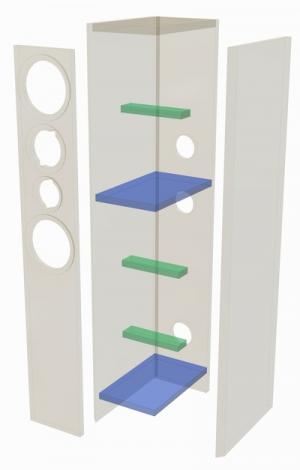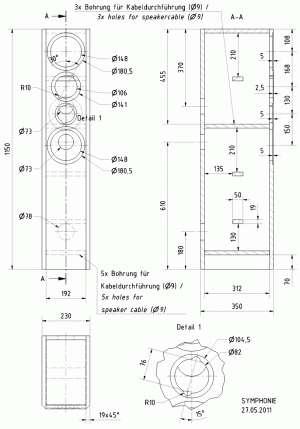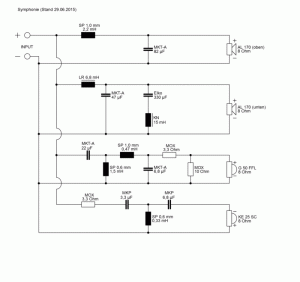SYMPHONIE
Building instruction
Exploded drawing
Assembly
All the cabinet panels are cut from 19 mm wooden boards, butt-jointed and glued. Construction is made easier if you start with the side wall. Glue to this the front panel, rear wall, lid and the base, which is offset towards the inside by 70 mm. Next, position the strengthening struts and spacers and glue them in place. Cut three holes (Ø 9 mm) in the inside spacer to allow the cables to be passed through. Finally, close the cabinetby gluing the other side in place.
To provide not only a pleasing appearance but also the best possible acoustics, the drivers should be recessed. This will require use of a router with the corresponding circle cutting tool. After that, the openings for the driver and terminals are cut out.
The crossover for the SYMPHONIE is mounted underneath the speaker on the outside of the base. This makes it easily accessible. Make sure the holes in the base for the cables (5 x Ø 9 mm) are aligned with the crossover outputs.
Once all the cables have been correctly routed inside the cabinet, seal off the cable holes in the spacer and base board with hot-melt glue, for example.
Inner damping
The damping material is loosely arranged in the cabinet. The space behind the bass reflex tubes should remain free.
Cabinet parts list for 1 box
Sketch
Crossover
Press
“Let's not beat about the bush: the high expectations we had of these speakers were not disappointed. Right from the start with Hugh Masekela's “Stimela” off his CD “Hope”, the vocals were excellent, and they covered the full range of volumes from precise, detailed and clear through to the threshold of pain. Bass reproduction is very clearly defined, without a hint of dullness and without coming across too thin. The cleverly arranged frequency spread with a slight emphasis on the bass provides exactly the right volume of sound to match the taughtness of the aluminium cone, but without exaggeration.
Both male and female voices are definitely a strong point of the Symphonie. Its ability to show off its well-balanced character at higher volume levels in a completely homogeneous manner or, alternatively, as a producer of quiet background music is impressive.”
“In practical tests, the Symphoniequickly showed its considerable talent in vocal reproduction. Both male and female voices are positioned clearly in the room, the finest details meticulously reproduced but the speakers never lose sight of their purpose by exaggerating. When the piece dictates that dynamism is required, things can get really lively: Mezzo-soprano Olga Borodina, for example, is truly explosive in Stravinsky's Pulcinella Suite. Nothing is compressed – the mid-range diaphragm offers its listeners tremendous dynamism that occasionally gets close to the limit. …
...The two aluminium woofers succeed in producing a combination of taughtness and volume seldom encountered. The bulge detected in our measurements between 60 and 150 hertz definitely exists but, rather than being a problem, it actually contributes to the clarity and taughtness of the bass, as only hard diaphragms are able to do. Precision of this kind can sometimes sound puritan so the subtle support for the low frequency range counters this tendency very effectively.
Set at a low volume, it is possible to listen to music on the Symphoniespeakers for long periods without ever becoming fatigued. Its capability in terms of vocal reproduction is a definite advantage here as even laid-back background music comes across with remarkably clear voices.
Set to a high volume level, the speaker lays bare the real quality of the musical recording. Any mistakes made by a sound engineer will not remain secret for very long. Even at the most ridiculous volume levels, these speakers retain full control and do not produce even the slightest hint of distortion. As a result, these speakers can be recommended with no qualms for large room well in excess of 50 square meters, while they are also very well suited to relatively small rooms.
Conclusion
With its Symphonie speakers, VISATON has produced a virtuoso voice system, an excellent listening monitor with studio qualities and an outstanding loudspeaker for everyday use which, even run at low volumes in the background, will enthral its audience.”


